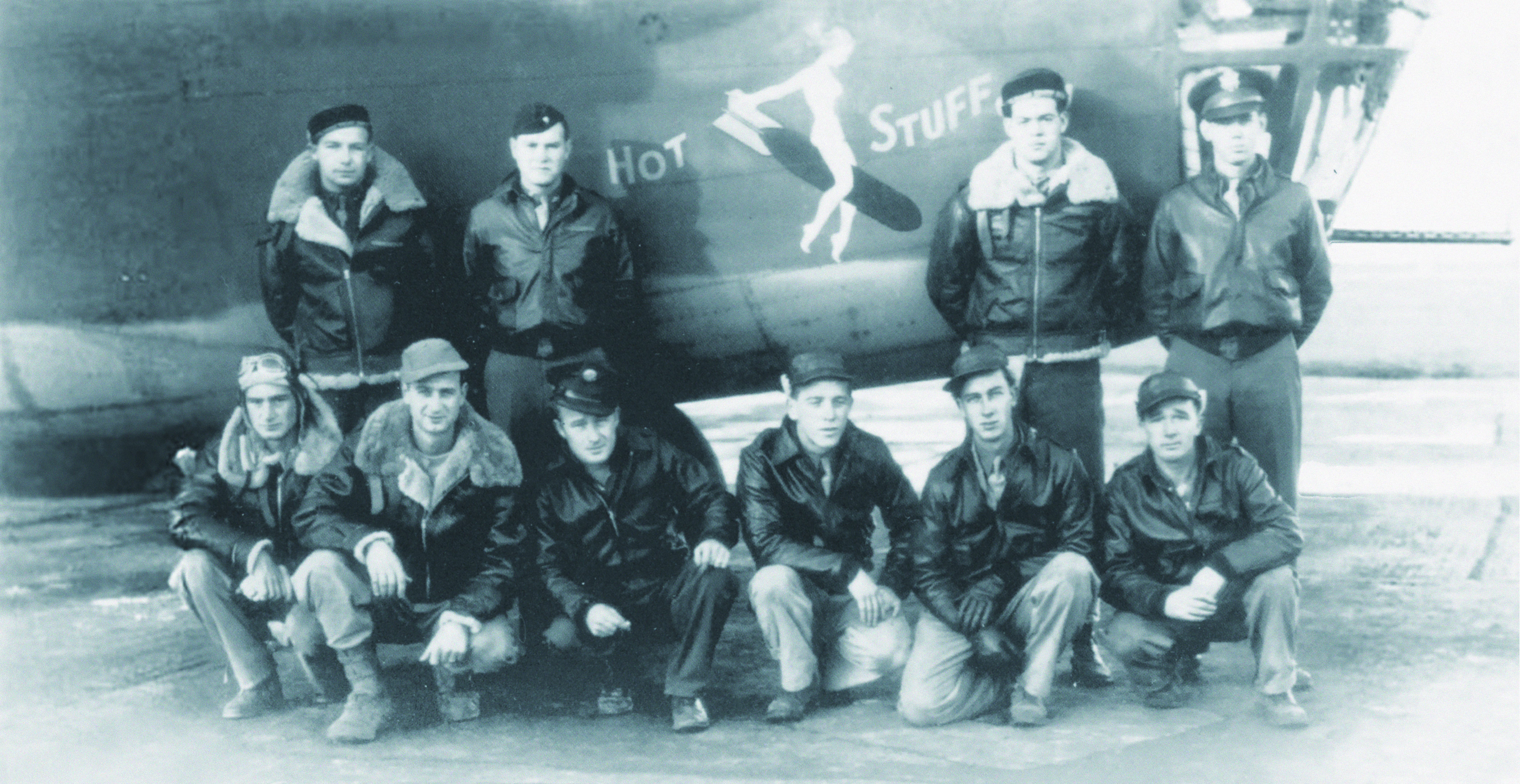[dropcap]A[/dropcap] Western Union telegram was enough to strike fear in the heart of any parent with a son in the service. “There never was a moment when the sight of a telegram didn’t make me jumpy,” said Ralph E. Shannon, a 55-year-old newspaper publisher in Iowa. Telegrams often brought bad news, and Shannon had reason to worry: his 27-year-old son, Bob, was a bomber pilot in England, flying combat missions with the U.S. Eighth Air Force.
When Shannon received a telegram on May 5, 1943, however, he expected the best of news. Just two days earlier, on May 3, Shannon had received a letter from Bob saying he had finished his combat tour—31 missions—and was on his way home. Shannon expected the telegram to announce that his son had arrived safely in the States. But when he opened the envelope, he read:
The Secretary of War desires that I assure you of his deep sympathy in the loss of your son, Captain Robert H. Shannon. Report just received states that he died May 3, 1943, in European area…
Shannon stared at the telegram in paralyzed disbelief. He tried to convince himself it was all a misunderstanding, that the army had fouled up royally. But he knew better. “The War Department doesn’t often make mistakes like that,” he admitted to himself, his hopes for his son’s return dashed. “It’s a long drop from the mountain top…to the very bottom of the abyss,” he thought as he mustered the strength to tell his wife, Fannie, that their son wouldn’t be coming home after all.
The Shannons were far from alone: during the war, more than 400,000 American families received similar heartbreaking telegrams. But while the Shannons’ grief was common, the circumstances of their son’s death was anything but ordinary. He had beaten remarkable odds and survived more combat missions over Europe and Africa than any other bomber pilot at the time. In a cruel collision of fate and chance, his luck ran out after his war seemed to have ended safely.
BORN IN 1916, Robert “Shine” Shannon had dreamed of flying. After attending Iowa State University, he enlisted in the army on July 11, 1941, and earned his wings. He was assigned to the 330th Squadron, 93rd Bombardment Group, and given command of a 10-man crew that included copilot John H. Lentz, a 23-year-old Chicago native; bombardier Robert T. Jacobson, 26, from Cedar, Mississippi; and George A. Eisel, a 32-year-old tail-gunner from Columbus, Ohio.
In August 1942, Shannon and his crew headed to Grenier Field, New Hampshire, for shipment overseas. They received a new plane, a B-24D Liberator heavy bomber, serial number 41-23728. With four 1,200-horsepower Pratt & Whitney engines, the Liberator had a maximum speed of 303 miles per hour and bristled with 11 .50-caliber machine guns. It had a range of more than 2,000 miles and could carry four tons of explosives. Proud of their new ship, Shannon and his crew named it Hot Stuff and adorned it with a painting of a nude woman straddling a falling bomb. They put their plane through its paces and flew across the Atlantic to their outfit’s new base in Alconbury, England, on September 5, 1942.
That fall, the Eighth Air Force was beginning its offensive against Germany, with B-17 and B-24 bombers based in England attacking military targets on the Continent. To the public, air combat held an aura of glamour; foot soldiers envied the airmen’s warm beds and hot meals, but the fliers knew the score. “Air combat spells romance, but it makes me piss my pants,” they sang in a barracks ballad titled “I Wanted Wings (‘til I Got the Goddamn Things).” Flying combat was a dangerous way to earn a living.
Liberators flew at altitudes higher than 20,000 feet, with temperatures hitting 50 degrees below zero and air too thin to breathe. Airmen relied on bulky clothing and heated flying suits to ward off frostbite, while cumbersome masks supplied oxygen. Mechanical failures were a fact of life; even a momentary lapse by a pilot on takeoff could turn a plane loaded with gasoline and bombs into an inferno.
Cannon and machine-gun fire from Luftwaffe fighter planes took their toll, too—but antiaircraft artillery was even deadlier, accounting for more than 85 percent of all in-plane casualties. In 1942, when Shannon began his tour, 310 American fliers were killed in the European Theater. The death toll rose to 4,637 the following year and to 12,845 in 1944. Plane losses rose correspondingly, with 50 heavy bombers lost in 1942, 1,183 in 1943, and 3,949 in 1944.
Due to these casualties and the stress of combat, the Eighth Air Force set up a rotation policy, sending airmen home on leave after completing a specified tour of duty and giving them hope for survival. On July 1, 1942, the War Department set a tour at one year. That was too long, Eighth Air Force commander Brigadier General Ira C. Eaker soon realized, as he saw his men become increasingly “tired, war-weary, and punch-drunk.” In January 1943, he unofficially reduced a tour to 25-30 missions; by late spring of 1943, 25 missions had become the accepted standard.
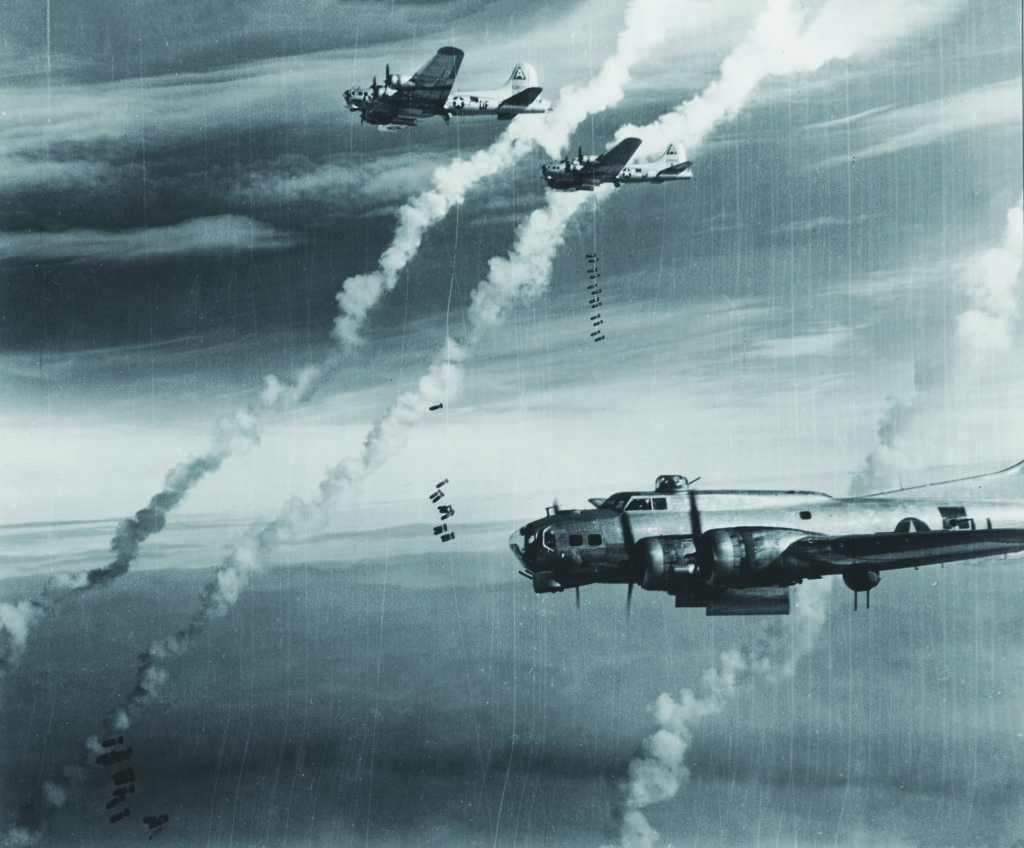
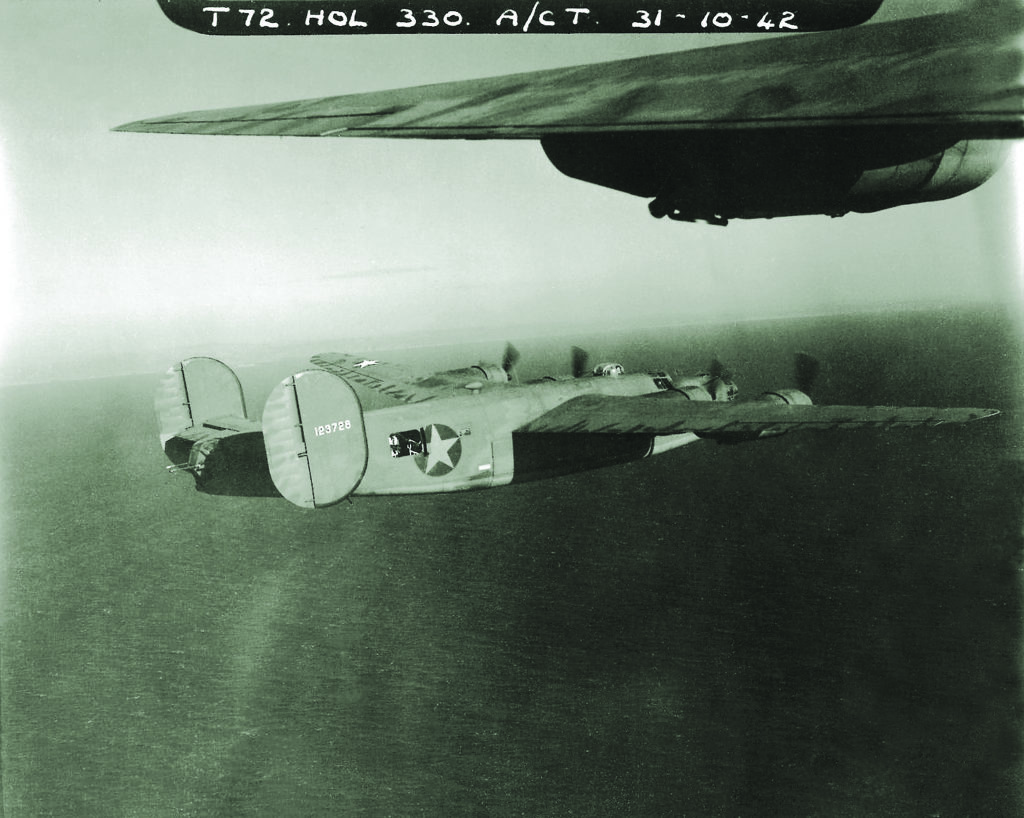
HOT STUFF AND ITS CREW saw their first action on October 21, 1942, in a 90-plane raid on U-boat pens at Lorient, France. Clouds ob-scured the target, and Hot Stuff wound up dumping its bombs in the English Channel. German fighters downed three other bombers, and Hot Stuff returned with its fuselage pockmarked with bullet holes. Throughout October and November, the B-24 flew a variety of missions: antisubmarine patrols over the ocean and bombing raids on U-boat bases at St. Nazaire, Brest, and again at Lorient. Patrols could be just as dangerous as bombing missions. On November 11, 1942, five enemy fighters ambushed Hot Stuff over the Atlantic. Machine-gun fire peppered the Liberator, but its crew downed three—possibly four—of the fighters. By the end of November, Shannon and his crew had racked up 10 missions.
In December 1942, the 93rd Bomb Group was sent south for a 10-day assignment in North Africa, where it earned the nickname “Ted’s Travelling Circus” in honor of group commander Colonel Edward J. “Ted” Timberlake Jr. Hot Stuff’s first base was a primitive airfield at Tafraoui, Algeria. “Tafraoui,” the men griped, “where the mud is always gooey.” Shannon and his crew were soon transferred to Gambut Main, a remote airfield in the Libyan desert, and their 10-day assignment stretched to three months.
Hot Stuff flew 17 missions from Tafraoui and Gambut Main, hitting targets in Africa, Sicily, and Naples, Italy. The crew’s luck held. While Hot Stuff often returned with battle damage, no crewman suffered even a scratch, plus tail-gunner Eisel was building a reputation for his deadly aim. Bombardier Jacobson estimated that Eisel had shot down two dozen enemy fighters. The total was unofficial, however, because Eisel was so busy shooting that “he doesn’t have time to watch them crash…(and) doesn’t get credit for them,” Jacobson wrote to his parents.
In late February 1943, the 93rd Bomb Group returned to England. Hot Stuff’s crew welcomed the tastier food and more comfortable quarters at Hardwick, their new base. Jacobson told his parents he was even gaining weight, “mostly around the waist.”
On March 17, 1943, Hot Stuff went back into action, flying a diversionary mission to draw fighters away from a raid on the marshalling yards in Rouen, France. The next day, Shannon and his crew hit Germany for the first time, bombing a submarine base near Bremen. “It was the hottest that we have been in,” Jacobson noted. “But we really plastered that place.” Ninety-seven bombers hit the U-boat base, but two planes and their crews were lost, 24 planes were badly damaged, and 16 airmen were wounded.
Hot Stuff flew its 30th mission on March 22, 1943, part of a 100-plane attack against the U-boat yards in Wilhelmshaven, Germany. Among the planes flying with Hot Stuff that day was a B-17 named Memphis Belle on what was its 16th mission. Three planes and their crews were lost, 22 planes were badly damaged, and 18 crewmen were wounded. Hot Stuff, however, came through unscathed, becoming the first heavy bomber in Europe to complete 30 missions.
On March 31, 1943, Hot Stuff flew its 31st and final combat mission in a 102-plane attack on shipyards in Rotterdam, Holland. If 25 missions were now considered a full tour, as the Eighth Air Force was in the process of confirming, then 31 missions were seen as more than enough. Shannon and his crew had survived. They had completed their tour, and their future looked bright. They’d rest in England for a few weeks and then fly back home to family and friends in America. The War Department planned to display the plane and its crew on a tour of the United States to boost morale and promote war-bond sales. The men didn’t know about the planned publicity, only that they were finally going home.
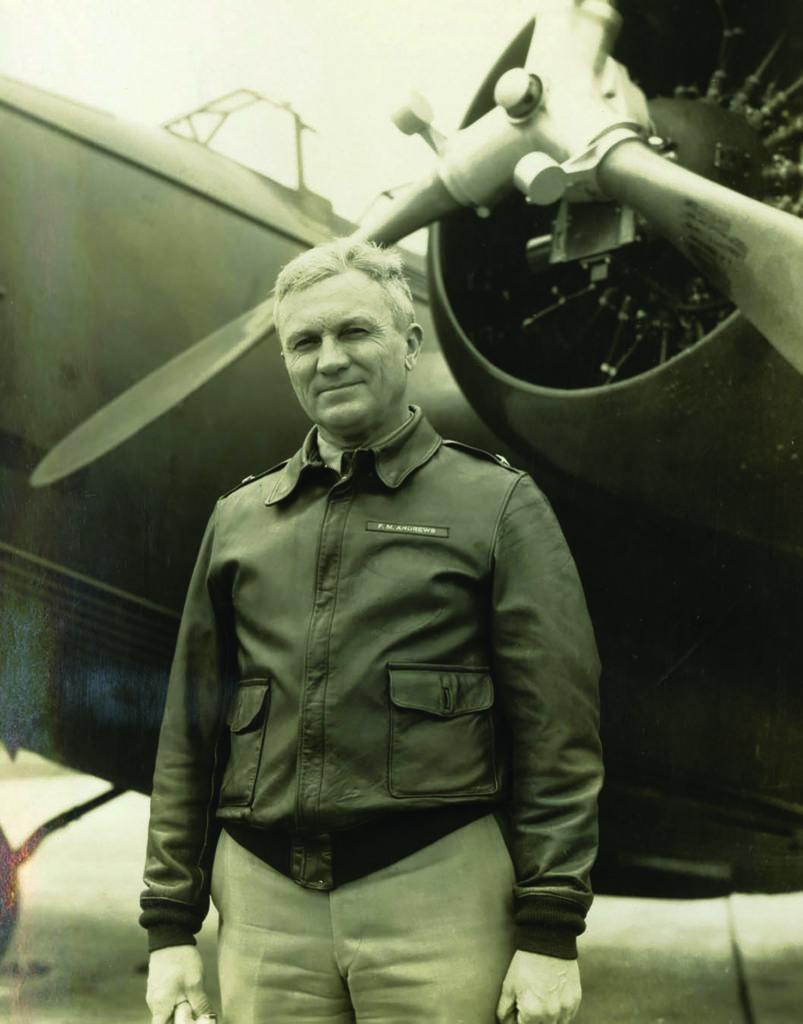
ON APRIL 27, 1943, Shannon received orders for Hot Stuff and its crew to report to Bovington, England. As a reward for completing 31 missions, Shannon and Hot Stuff would have the honor of flying Lieutenant General Frank M. Andrews to Reykjavík, Iceland, on their way home. The 59-year-old Andrews, described by the Washington, D.C., Evening Star as a “square-jawed, deeply tanned, and hard-fighting man,” was commander of all U.S. forces in the European Theater.
Officially, Andrews’s trip was billed as an inspection tour of American bases in Iceland. But Iceland was also a stepping stone for trans-atlantic flights—and Andrews seemed to be in too much of a rush for a routine inspection. He was a rising star in the army; many historians believe its chief of staff, General George C. Marshall, had called him to Washington to be groomed to command the planned invasion of France. The timing was right because the Trident Conference, where concrete plans for invasions of the Continent were to be discussed, was scheduled to begin in Washington on May 12. Copilot Lentz later said he and Shannon were told that Andrews was heading back to the United States, with Iceland only a fueling stop.
General Andrews had been piloting planes since 1918. Rated a command pilot, he still liked to take the controls, and he would make the trip to Reykjavík as Shannon’s copilot in place of Lentz, who stayed behind in England. The general’s friends and colleagues had suggested he stay out of the cockpit, as they considered it an unnecessary risk for such a high-ranking officer, but he refused. “I don’t want to be one of those generals who die in bed,” he joked. Andrews’s party—an eight-man entourage that included members of his staff plus Bishop Adna Wright Leonard, whom President Franklin D. Roosevelt had sent to England to assess army chaplaincy operations—bumped bombardier Jacobson and gunners Joseph L. Craighead, Grant Rondeau, and George D. Farley. Of Hot Stuff’s regular crew, only Shannon, navigator James E. Gott, radio operator Kenneth A. Jeffers, gunner Paul H. McQueen, and tail-gunner Eisel would make the flight.
Air Transport Command (ATC) regulations required all flights to Iceland to depart from Prestwick, an airbase in Scotland. There, crews got the latest weather reports; if the forecast in Iceland was dicey, planes would not be cleared for departure, which could mean a long delay. Andrews was in a hurry; his staff told ATC that the general wanted to “avoid the delay involved by staying to brief and refuel” at Prestwick and instead fly directly from Bovington to Reykjavík. But when ATC pressed the issue, Andrews reluctantly said he would stop at Prestwick.
At 7:22 a.m. on May 3, 1943, Hot Stuff took off from Bovington with Andrews at the controls. But it didn’t stop at Prestwick. At 10 a.m., crewman Jeffers radioed, “Proceeding Reykjavík. Assuming weather O.K. unless notified differently.” The weather report was radioed to Hot Stuff, and it showed conditions unfit for flying: solid cloud cover at 800 feet, rain, poor visibility, and ice forming at 1,000 feet. Hot Stuff acknowledged the report and continued, reaching the coast of Iceland at 1:49 p.m. The weather was as bad as predicted. To make matters worse, the plane’s radio stopped working—possibly from ice accumulating on the radio antenna—and Hot Stuff lost all contact with ground bases. Landing at Reykjavík was out of the question, so Shannon and Andrews flew below the clouds at 40-200 feet, looking for a suitable airfield.
At 2:38 p.m., the plane reached the British air base at Kaldadarnes in southern Iceland. The bomber circled the field five times and requested permission to make an emergency landing by dropping red flares. Kaldadarnes shot up a green flare, signaling permission—but Shannon and Andrews didn’t see it and flew west, hugging the coastline. A half-hour later, personnel at Meeks Field, an American airbase fewer than 30 miles from Kaldadarnes, heard Hot Stuff’s engines, but Shannon and Andrews apparently couldn’t see the field and headed back toward Kaldadarnes. Eisel, riding in the tail section, recognized the distinctive flying style of Shannon, who had started his career as a fighter pilot; he knew Shannon had taken the controls from Andrews.
A short time later—at about the same time an elated Ralph Shannon was reading that his son would soon be home—Hot Stuff crashed into 1,100-foot-high Mount Fagradalsfjall, near Iceland’s southern coast. The ship had encountered a low cloud formation that had blinded Shannon. Thirteen of the 14 onboard were killed instantly. The bodies of Shannon and Andrews were hurled from the wreckage, still strapped to their seats.
Only Eisel survived the crash, and his situation was precarious: The plane was on fire, and he was pinned in the wreckage. But he got a break that saved his life—the driving rain soon doused the flames, and only his eyelashes were singed.
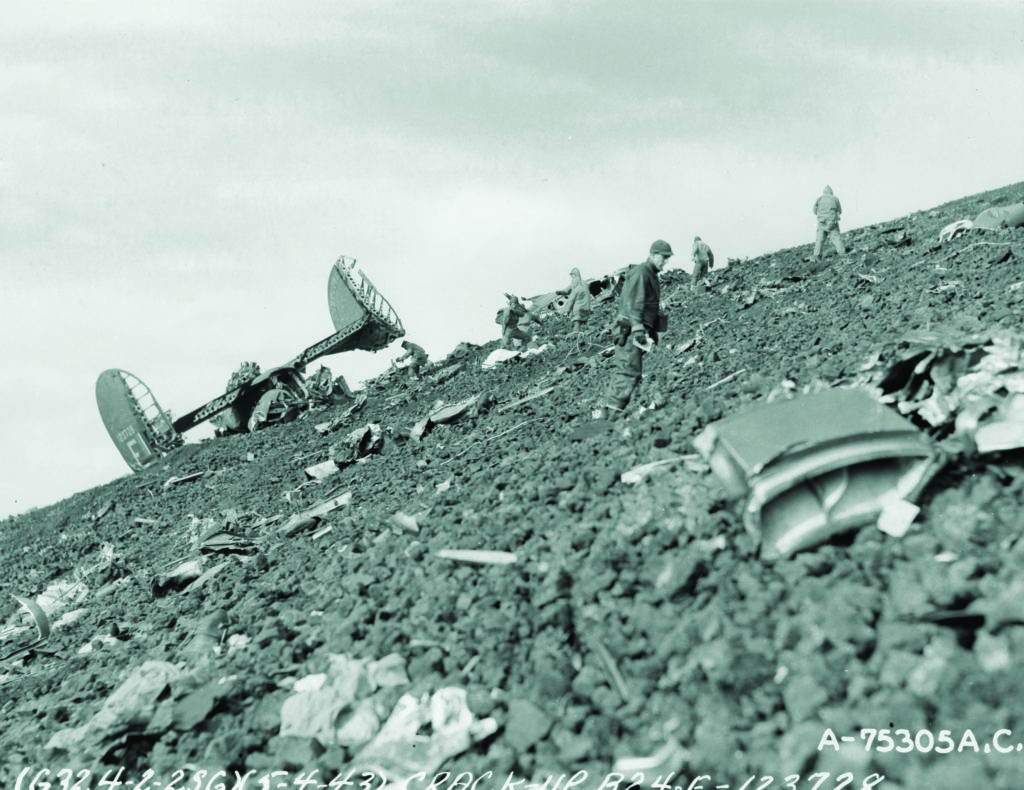
WHEN HOT STUFF DIDN’T ARRIVE at Reykjavík, search teams combed the Icelandic countryside and shoreline in planes and ships. The next day, May 4, 1943, dawned sunny and clear—perfect flying weather—and a search plane spotted the wreckage at 9:45 a.m. Only the tail section was recognizable; debris scattered about made it appear unlikely anyone had survived. A rescue party navigated the difficult terrain and reached the wreckage hours later. The rescuers were shocked to find Eisel still alive, 26 hours after the crash; it took an additional hour to extricate him and carry him to an ambulance waiting a mile away.
No one was to blame for the crash, military investigators concluded. Bad weather and the loss of radio contact had doomed Hot Stuff. They found that Andrews had known the weather in Iceland was bad before he reached the coastline. As for bypassing Prestwick, the investigators determined that, as theater commander, Andrews had the authority “to exercise his prerogative to proceed to Iceland, a part of his Command, without landing at Prestwick.”
Two weeks later, on May 17, B-17 Memphis Belle flew its 25th mission, a raid on the submarine pens at Lorient—a target Hot Stuff had hit twice. On June 16, 1943, Belle returned to the United States, landing in Washington, D.C., to great acclaim. Hot Stuff had completed its combat tour six weeks before Belle did; news accounts accurately called Belle the first combat bomber to come home after 25 missions, not the first to complete 25 missions. But Belle became the bomber of legend when the plane and its crew embarked on the publicity campaign and bond tour originally planned for Hot Stuff.
Lentz couldn’t help wondering if Hot Stuff’s final flight might have ended differently if he, not Andrews, had been sitting alongside Shannon. He and Shannon had been a good team. The copilot returned to the United States in December 1943 and was assigned to ferry cargo across the country. After 31 combat missions, his most perilous flight came far from a battlefield. On March 24, 1944, while flying a B-24H from Romulus, Michigan, to Tuscaloosa, Alabama, an engine caught fire and his plane began losing altitude. He ordered his crew to bail out, but he stayed with the plane “to keep it from going wild in the sky and cracking into somebody’s house and perhaps killing someone,” he later said. He crash-landed near Birmingham, Alabama. Although seriously injured, he survived, and no one on the ground was hurt.
Bombardier Jacobson, too, returned home. Later assigned to the Pacific Theater, he flew 14 combat missions over Japan as a B-29 bombardier. His final flight was on August 14, 1945, as part of a 752-plane raid—the last bombing mission of the war.
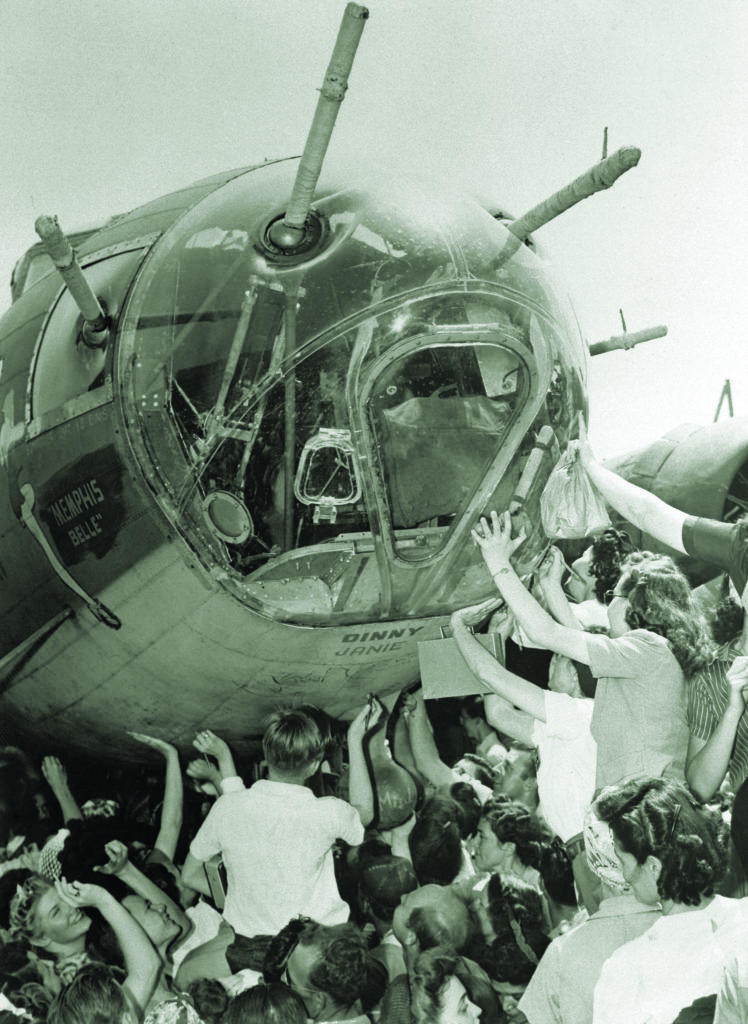
IN IOWA, Ralph Shannon struggled to come to grips with his son’s death. “Bitterness and self-pity look pretty attractive, and it would be easy to yield to them,” he thought. He knew that losing a son in war is “as old as the human race,” but he still grappled with the unanswerable question: “why did it happen to us?”
Every memory of Bob hit his father with “surges of grief as overwhelming as they are unexplainable.” As a form of therapy, Shannon wrote letters to his late son. “You have given your life, yes,” he wrote in one. “But you gave us 20-some years of it, and we are deeply grateful for those years. The balance went for your country and to those who are groping for higher ground in his war-racked world.” The ultimate goal was lasting peace, Ralph continued, and “yours may be one of the threads needed to complete that glorious legend. Goodnight, Son!” ✯
This story was originally published in the October 2019 issue of World War II magazine. Subscribe here.

